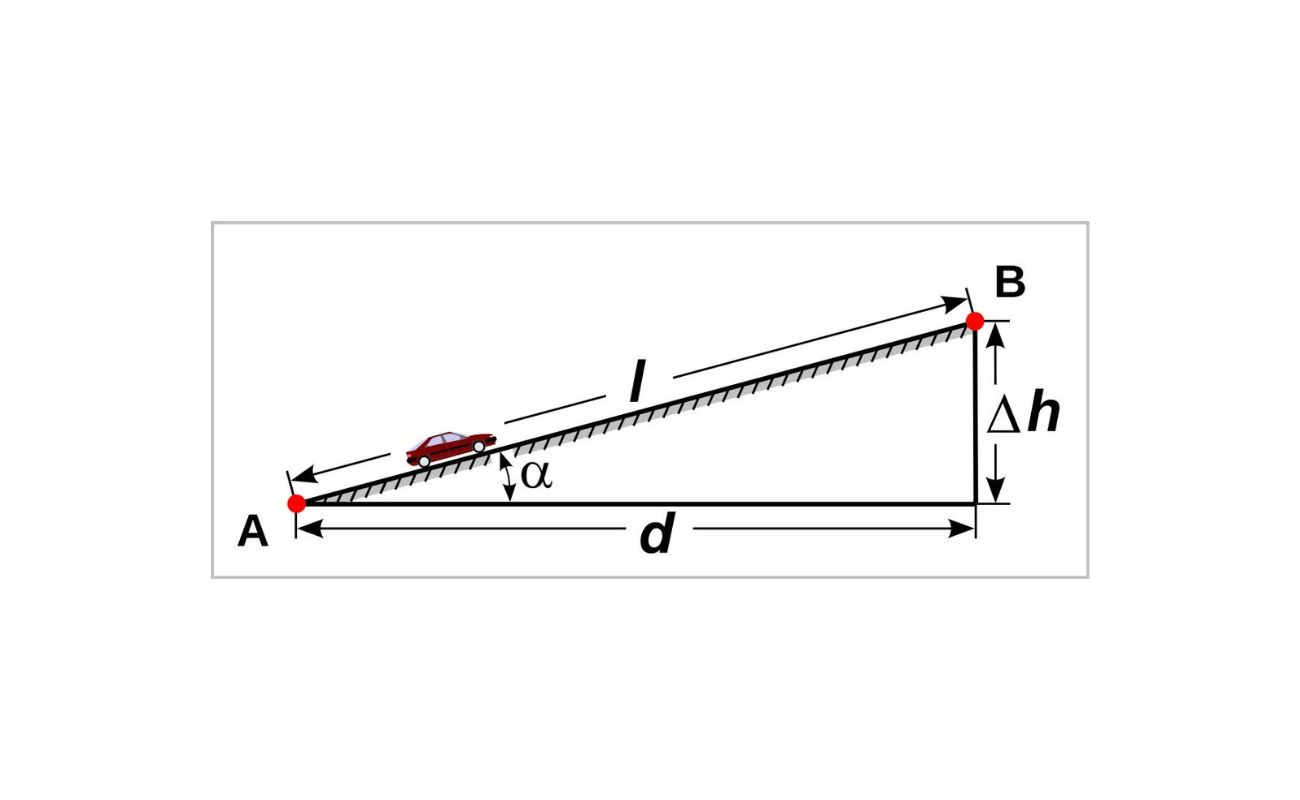Home>diy>Planning & Engineering>What Is Gradient In Civil Engineering


Planning & Engineering
What Is Gradient In Civil Engineering
Modified: May 6, 2024
Learn the fundamentals of gradient in civil engineering and its role in planning and engineering projects. Discover how to calculate and incorporate gradients for optimal design and functionality.
(Many of the links in this article redirect to a specific reviewed product. Your purchase of these products through affiliate links helps to generate commission for Storables.com, at no extra cost. Learn more)
Introduction
In the field of civil engineering, gradients play a crucial role in various design and construction processes. A gradient, also known as a slope or incline, refers to the change in elevation over a given horizontal distance. It is an essential concept that determines the steepness and direction of surfaces such as roads, railways, canals, and pipelines. Understanding and calculating gradients accurately are vital for ensuring the safety, functionality, and efficiency of civil engineering projects.
Gradients are an inherent part of our daily lives, whether we realize it or not. From the highways we drive on to the water systems we rely on, gradients form the foundation of these infrastructure systems. They dictate the flow of water, control vehicular movement, and even affect the efficiency of energy transfer in pipelines.
In this article, we will delve into the world of gradients in civil engineering, exploring their definition, importance, calculation methods, types, applications, and the challenges and considerations that come with working with gradients. By the end of this article, you will have a comprehensive understanding of the significance of gradients and how they shape the built environment.
Key Takeaways:
- Gradients are crucial in civil engineering, determining the slope of surfaces and impacting drainage, transportation, energy efficiency, and more. Understanding and calculating gradients accurately is essential for safe and efficient infrastructure design.
- Civil engineers face challenges when working with gradients, including site topography, environmental impact, geotechnical considerations, accessibility, maintenance, construction methods, and compliance with regulations. Addressing these factors is vital for successful and sustainable infrastructure projects.
Read more: What Is A Civil Engineering Technician
Definition of Gradient
In civil engineering, the gradient refers to the change in vertical elevation per unit horizontal distance along a particular path or surface. It is often expressed as a ratio or percentage. The gradient determines the steepness or slope of a surface and is a crucial factor in designing and constructing various infrastructure projects.
The gradient is calculated by dividing the change in elevation (Δh) between two points by the horizontal distance (Δx) between those points. The most common way to express the gradient is as a ratio, such as 1:20 or 1/20. This means that for every 1 unit of horizontal distance, there is a 20-unit change in elevation. Another way to express the gradient is as a percentage, such as 5%. This indicates that the elevation changes by 5 units for every 100 units of horizontal distance.
Gradients can be positive or negative, indicating an upward or downward slope, respectively. A positive gradient means that there is an increase in elevation along the direction of the path, while a negative gradient indicates a decrease in elevation.
It’s important to note that the gradient is not limited to linear surfaces. It can also be calculated for curved surfaces, taking into consideration the change in elevation over a small section of the curved path.
In summary, the gradient in civil engineering refers to the change in vertical elevation per unit horizontal distance along a path or surface. It is used to determine the slope or steepness of a surface and plays a vital role in the design, construction, and maintenance of infrastructure projects.
Importance of Gradient in Civil Engineering
The gradient is a fundamental component of civil engineering design and construction. It holds significant importance in ensuring the functionality, safety, and efficiency of infrastructure projects. Here are several key reasons why gradients are essential in civil engineering:
- Drainage and Water Management: Proper gradient design is crucial for efficient drainage systems, such as stormwater channels and pipes. By providing a downward slope, water can flow naturally and effectively away from a given area, preventing flooding, erosion, and water-related damages. Additionally, gradients are essential in the design of canals and rivers to maintain a continuous flow of water.
- Transportation Infrastructure: Gradients play a vital role in road and railway design. The appropriate slope ensures the safe movement of vehicles and trains. Steep gradients may lead to accidents, while insufficient gradients can cause issues like insufficient drainage and reduced vehicle performance. Proper gradient design in transportation infrastructure ensures smooth and efficient movement of goods and people.
- Pipeline and Utility Routing: In the design of pipelines for water, gas, oil, or other utilities, gradients are necessary to ensure proper flow and pressure. An appropriate slope allows the fluid or gas to move smoothly and efficiently through the pipes, reducing the need for additional pumping or maintenance.
- Construction and Earthworks: Gradients are crucial in excavation and earthmoving activities. They determine the excavation depth required and the slope of the cut or embankment. Proper gradient design ensures the stability of slopes, minimizes soil erosion, and reduces the risk of landslides or slope failures.
- Energy Efficiency: In the design of hydropower plants, gradients are essential for efficient energy generation. By controlling the water flow through turbines, the gradient allows for the maximum conversion of potential energy into electricity. Similarly, gradients play a role in the design of gravity-fed irrigation systems, optimizing water distribution and minimizing energy consumption.
These are just a few examples highlighting the importance of gradients in civil engineering. Proper gradient design ensures the functionality, safety, and cost-effectiveness of infrastructure projects. It enables the efficient movement of water, vehicles, and utilities, reduces environmental impact, and maximizes resource utilization. A thorough understanding of gradients is crucial for civil engineers to create sustainable and well-designed infrastructure systems.
Calculation of Gradient
The calculation of gradients in civil engineering involves determining the change in elevation over a given horizontal distance. This calculation is essential for accurately designing and constructing infrastructure projects. There are two commonly used methods to calculate gradients: the ratio method and the percentage method.
Ratio Method: The ratio method expresses the gradient as a ratio, such as 1:20 or 1/20. To calculate the gradient using this method, divide the change in vertical elevation (Δh) by the horizontal distance (Δx) between two points:
Gradient = Δh/Δx
For example, if the vertical elevation changes by 10 meters over a horizontal distance of 200 meters, the gradient would be 10/200 or 1:20.
Percentage Method: The percentage method expresses the gradient as a percentage. To calculate the gradient using this method, divide the change in vertical elevation (Δh) by the horizontal distance (Δx) and multiply by 100:
Gradient = (Δh/Δx) * 100
Using the same example as above, if the vertical elevation changes by 10 meters over a horizontal distance of 200 meters, the gradient would be (10/200) * 100 or 5%.
It’s important to note that when using the ratio method, the first number represents the change in elevation (rise), and the second number represents the horizontal distance (run). The larger the second number, the flatter the gradient, while a smaller second number indicates a steeper slope.
These calculation methods can be applied to straight or curved gradients. For curved surfaces, the change in elevation and horizontal distance should be determined between small sections or intervals, and the calculations can be repeated to find the overall gradient.
Accurate calculation of gradients is crucial for ensuring the safety, functionality, and overall performance of civil engineering projects. It allows for proper design and construction, optimized fluid flow, and efficient utilization of resources.
In civil engineering, gradient refers to the slope of a road, railway, or pipeline. It is expressed as a ratio of vertical rise to horizontal distance and is important for ensuring proper drainage and stability of the infrastructure.
Types of Gradients in Civil Engineering
In civil engineering, gradients can take on various forms depending on the specific requirements and characteristics of the project. Here are some common types of gradients:
- Uniform Gradient: A uniform gradient refers to a constant slope along a given path or surface. In this type of gradient, the change in elevation remains consistent over the entire horizontal distance. Uniform gradients are commonly used in road construction, railways, and drainage systems.
- Stepped Gradient: A stepped gradient consists of multiple uniform gradients with different slopes. It is often used in situations where a significant change in elevation occurs within a short horizontal distance. Stepped gradients are frequently employed in terraced agriculture, staircases, and sports stadiums.
- Varying Gradient: A varying gradient refers to a slope that changes gradually along the path. This type of gradient is commonly used in road design to accommodate terrain variations, curves, or merging lanes. Varying gradients ensure a smooth and efficient transition between different slope levels.
- Compound Gradient: A compound gradient consists of different segments with varying slopes. It is often used in road and railway design to overcome challenging terrain with significant elevation changes. Compound gradients include a combination of uniform, stepped, and varying gradients to achieve an optimized and safe route.
- Reverse Gradient: A reverse gradient, also known as an adverse gradient, occurs when there is a temporary change in the direction of slope along a path. This type of gradient is typically used in situations where slowing down or braking is required, such as in downhill roads or railway tracks.
- Longitudinal Gradient: A longitudinal gradient refers to the slope along the lengthwise direction of a road, railway, or canal. It is essential for maintaining a consistent flow of water, minimizing erosion, and ensuring the smooth movement of vehicles or fluids.
- Transverse Gradient: A transverse gradient, also known as a cross slope, refers to the slope across the width of a road or railway. It is primarily used for ensuring proper drainage by allowing water to flow toward the edges of the pavement or tracks.
These are just a few examples of the types of gradients commonly encountered in civil engineering. Each type has its own design considerations and applications, and proper selection and implementation of the gradient type are crucial for achieving the desired functionality and performance of infrastructure projects.
Applications of Gradient in Civil Engineering
The concept of gradient is extensively applied in various fields of civil engineering, contributing to the design, construction, and maintenance of infrastructure projects. Here are some key applications of gradient in civil engineering:
- Highway and Road Design: Gradients play a crucial role in highway and road design. Properly designed gradients ensure the safety and functionality of roads by allowing vehicles to navigate hills and curves smoothly. The inclusion of appropriate gradients also assists in effective drainage to prevent water accumulation on road surfaces.
- Railway Design: Gradients are essential in railway design to enable trains to overcome elevation changes. By incorporating properly designed gradients, trains can maintain their speed and efficiency while ensuring passenger comfort and safety. Additionally, gradients in railway track design facilitate water drainage and reduce the risk of track failure due to water accumulation.
- Canal and Irrigation Systems: Gradients are used in the design of canals and irrigation systems to ensure the controlled flow of water from high to low-lying areas. Properly designed gradients enable efficient water distribution for agricultural purposes, ensuring that fields receive adequate water without causing waterlogging or soil erosion.
- Pipeline Routing: Gradients are critical in pipeline routing for utilities such as water, oil, gas, and wastewater. Appropriate gradients ensure the smooth flow of liquids or gases through the pipelines, minimizing the need for additional pumping and reducing energy consumption. The inclusion of gradients also aids in the prevention of blockages and sedimentation within the pipelines.
- Stormwater Management: In stormwater management systems, gradients are used to facilitate the natural flow of water from higher to lower elevations. Properly designed gradients ensure effective drainage, reducing the risk of flooding, erosion, and damage to infrastructure and property caused by excessive water accumulation.
- Slope Stabilization: Gradients are considered in slope stabilization measures to prevent landslides and slope failures. By analyzing and modifying the gradients of natural or artificial slopes, civil engineers can enhance the stability of the terrain, reducing the risk of soil erosion and the potential for catastrophic slope failures.
- Hydropower Generation: Gradients are crucial in hydropower generation systems, such as hydroelectric dams. The slope of the reservoir and the penstock determines the flow rate and pressure of water, which drives the turbines to generate electricity. Properly designed gradients maximize energy conversion and optimize the efficiency of hydropower plants.
These are just a few examples of how gradients are applied in various civil engineering applications. The consideration and implementation of appropriate gradients are crucial for achieving safe, efficient, and sustainable infrastructure systems.
Challenges and Considerations in Working with Gradients
While gradients are essential in civil engineering, they can present several challenges and considerations that engineers must address during the design and construction phases of projects. Here are some key challenges and considerations when working with gradients:
- Site Topography: The natural topography of the site can present challenges when designing and implementing gradients. Steep or uneven terrain may require additional engineering measures to ensure stability and safe construction. Proper site assessment and surveying are crucial for understanding the site’s topography and determining the most suitable gradient design.
- Environmental Impact: Changes in gradients within a project can impact the natural environment. Steep gradients can increase the risk of soil erosion, sedimentation in nearby water bodies, and disturbance to ecosystems. It is important for engineers to consider the potential environmental impacts and implement measures to minimize adverse effects, such as erosion control methods.
- Geotechnical Considerations: The soil and geological conditions of the site influence the stability and feasibility of implementing specific gradients. Soft soils or unstable ground conditions may limit the steepness of gradients or require additional reinforcement measures. A thorough geotechnical investigation is necessary to assess the soil properties and determine the appropriate gradient design.
- Accessibility and Safety: Steep gradients can pose challenges in terms of accessibility and safety, especially in transportation infrastructure projects. Careful consideration must be given to the requirements of vehicles or trains navigating the slope, ensuring adequate sightlines, appropriate signage, and safe maneuverability. Adequate roadside barriers and guardrails may also be necessary to protect against steep drop-offs.
- Maintenance and Operation: Gradients affect the maintenance and operation of infrastructure systems. Steeper gradients may require more frequent maintenance on roads, railways, and drainage systems due to increased wear and erosion. Accessibility for maintenance vehicles and equipment should be considered during the design phase to ensure ease of operation and efficient upkeep.
- Construction Methods: The construction of gradients requires careful planning and consideration of suitable construction methods. Steep gradients may require excavation and earthwork to create a stable slope. Proper erosion control measures, such as terracing or retaining walls, may be necessary to prevent slope failures during construction and throughout the lifespan of the project.
- Local Regulations and Standards: Compliance with local regulations and engineering standards is critical when designing and implementing gradients. Different regions or jurisdictions may have specific requirements for gradients in various infrastructure projects. Engineers must ensure that the designed gradients adhere to these regulations to meet safety and functional requirements.
Civil engineers must address these challenges and considerations when working with gradients to ensure the successful implementation of infrastructure projects. By considering site conditions, environmental impact, geotechnical factors, accessibility, maintenance requirements, construction methods, and local regulations, engineers can design gradients that are safe, efficient, and sustainable.
Conclusion
Gradients play a critical role in the field of civil engineering, shaping the design, construction, and functionality of infrastructure projects. The accurate calculation and thoughtful consideration of gradients are vital for ensuring the safety, efficiency, and sustainability of roads, railways, canals, pipelines, and other civil engineering systems.
Throughout this article, we have explored the definition of gradients and their importance in civil engineering. We have discussed the various calculation methods, including the ratio and percentage methods, and examined different types of gradients commonly encountered in engineering projects.
The applications of gradients in civil engineering are diverse and wide-ranging. From highway and railway design to drainage systems, pipelines, slope stabilization, and hydropower generation, gradients are indispensable in facilitating the proper flow of water, vehicles, and utilities, as well as optimizing energy efficiency.
However, working with gradients presents its own set of challenges and considerations. Engineers must address factors such as site topography, environmental impact, geotechnical conditions, accessibility, maintenance requirements, construction methods, and adherence to local regulations and standards.
In conclusion, gradients are fundamental in the world of civil engineering, shaping the built environment we live in. By understanding and effectively working with gradients, civil engineers can create functional, safe, and sustainable infrastructure that improves our lives and supports economic growth. As our society continues to evolve, the importance of gradients in civil engineering will remain steadfast, guiding the efficient and responsible development of our infrastructure.
Now that you've gained insight into gradients and their vital role in civil engineering, you might be curious about other aspects of project planning and execution. For those keen on understanding the organizational side, delving into "Construction Management" will shed light on how projects stay efficient, meet deadlines, and maintain budgets. This exploration will equip you with the essential knowledge to oversee complex construction tasks effectively.
Frequently Asked Questions about What Is Gradient In Civil Engineering
Was this page helpful?
At Storables.com, we guarantee accurate and reliable information. Our content, validated by Expert Board Contributors, is crafted following stringent Editorial Policies. We're committed to providing you with well-researched, expert-backed insights for all your informational needs.















0 thoughts on “What Is Gradient In Civil Engineering”